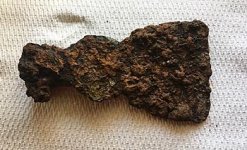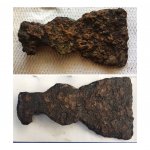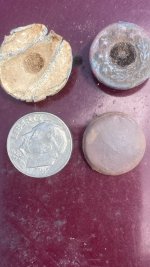neodetectorist
Bronze Member
Any hope for the axe head to be restored through electrolysis?
I am thinking of making a homemade electrolysis set up with the bucket, arm and hammer wash soda, anode, and a 15V-5A power supply.
I figured I would use a heavy copper wire ring for the anode connected to the positive terminal of the supply.
Fill the bucket with water and soda wash, putting the ring into the bottom of the bucket into the solution.
The negative lead to the axe, and placing the axe into the copper wire ring in the solution.
Is this the correct method?
Is this axe to far gone?
Any other suggestions?

I am thinking of making a homemade electrolysis set up with the bucket, arm and hammer wash soda, anode, and a 15V-5A power supply.
I figured I would use a heavy copper wire ring for the anode connected to the positive terminal of the supply.
Fill the bucket with water and soda wash, putting the ring into the bottom of the bucket into the solution.
The negative lead to the axe, and placing the axe into the copper wire ring in the solution.
Is this the correct method?
Is this axe to far gone?
Any other suggestions?






